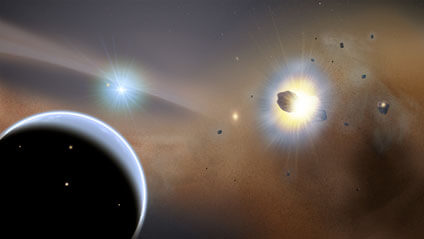Astronomers have discovered fragments of comets breaking up after colliding with a neighboring solar system. The researchers believe that they are witnessing the complete destruction of one of these ice bodies every five minutes.

Image: NASA Goddard Space Flight Center/F. Reddy
Astronomers using the Atacama Large Millimeter/submillimeter Array (ALMA) telescope have discovered the remnants of cometary collisions in another solar system. They estimate that such a collision occurs there every five minutes.
The "smoking gun" of this icy destruction was discovered in a relatively small area of a cloud of carbon monoxide gas swirling around the nearby young star Beta Pictoris.
"Carbon monoxide molecules can only survive around the star for a short period of time, about a century, before they are destroyed by ultraviolet radiation," says Bill Dent, a researcher at the Alma headquarters in Santiago, Chile, and the lead researcher on the article published in the journal Science. "Unless Beta Pictoris happens to be in an unusual period, the chances are that the carbon monoxide we see came from a renewable source."
"Comets and other icy bodies trap large amounts of CO and other gases in their initial freezing process. When such objects collide, which is common in chaotic environments such as those that exist near young stars, then the carbon monoxide gas will be distributed evenly."
But new images from Alma show something else: a single compact clump of carbon monoxide about 13 billion kilometers from the Sun, or three times the distance of Neptune-Rahab from our Sun. "These clumps provide an important clue to what is happening in the outer regions of this young planetary system," says Mark Wyatt, an astronomer at the University of Cambridge and co-author of the paper.
Early observations of Beta Pictoris with other telescopes revealed that it is surrounded by a large disk of dusty debris and is orbited by at least one planet 1.2 billion kilometers from the star.
Alma's new data suggests there may be a second, as-yet-undiscovered planet orbiting the star at a greater distance. The gravity of such a planet may guide millions of cometary bodies into a relatively dense region. A similar phenomenon is seen in our solar system when the planet Jupiter keeps a group known as "Trojan asteroids" in a fixed orbit around the sun.
"The rate of collisions must be very fast to get an amount of carbon monoxide that is equivalent to a sixth of the mass of the oceans on Earth, when the total destruction of a large comet occurs once every five minutes," says Aki Roberge, an astronomer at NASA's Goddard Space Flight Center in Maryland. He is also a research partner. "To get such a number of collisions, a massive, dense swarm of comets is needed."
Another possibility is that instead of one large planet steering the comets into collision, the fragments were formed by the collision of two Mars-sized planets within the last million years. Even in that case we will get dense comet-like remnants surrounding the star. Such a process, by the way, would be rare and there is a low probability that it occurred such a short time ago when the fractures are still so concentrated."
Both possibilities give astronomers reason to be optimistic that there are more planets awaiting discovery in the Beta Factoris system, located 63 light-years from Earth in the southern group Fector.
"Alma's unprecedented resolution and the telescope's sensitivity allow astronomers to detect the subtle millimeter and submillimeter wavelength light emitted by both dust nuclei and carbon monoxide in the system."
"Carbon monoxide is just the beginning: it is possible that more complex pre-organic molecules are released from these bodies of ice," Roberge said.
The astronomers hope that further observations by Alma will shed more light on the system and help to understand the conditions that occurred during the formation of our solar system.
Alma is an international observatory jointly owned by countries from Europe, North America and Asia in partnership with the Republic of Chile. The construction and operation of the observatory is carried out for Europe by the European Southern Observatory (ESO) - a body that Israeli astronomers also want to join. For North American countries, it is managed by the National Radio Observatory in the USA (NRAO). From Asia it is managed by the National Astronomical Observatory of Japan (NAOJ) and a joint management stands over them all.
